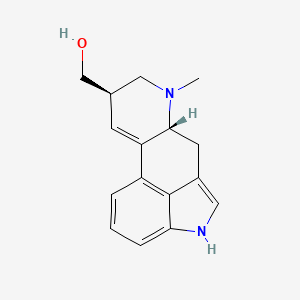



1. 9,10-didehydro-6-methylergoline-8b-methanol
2. Isolysergol
3. Lysergol, (8alpha)-isomer
1. 602-85-7
2. Lysergole
3. Ntr684z1az
4. Chembl39947
5. 1413-67-8
6. Chebi:60528
7. [(6ar,9r)-7-methyl-6,6a,8,9-tetrahydro-4h-indolo[4,3-fg]quinolin-9-yl]methanol
8. ((6ar,9r)-7-methyl-4,6,6a,7,8,9-hexahydroindolo[4,3-fg]quinolin-9-yl)methanol
9. (6-methyl-9,10-didehydroergolin-8beta-yl)methanol
10. 9,10-didehydro-6-methyl-8-hydroxymethylergoline
11. (7-methyl-4,6,6a,7,8,9-hexahydro-indolo(4,3-fg)quinolin-9-yl)-methanol
12. (7-methyl-4,6,6a,7,8,9-hexahydro-indolo[4,3-fg]quinolin-9-yl)-methanol
13. [(6ar,9r)-7-methyl-6,6a,8,9-tetrahydro-4h-indolo[4,3-fg]quinoline-9-yl]methanol
14. Lol
15. Prestwick_308
16. Prestwick0_000454
17. Prestwick1_000454
18. Prestwick2_000454
19. Prestwick3_000454
20. Unii-ntr684z1az
21. Bspbio_000528
22. Gtpl123
23. Cid_14987
24. Mls001049075
25. Divk1c_000515
26. Schembl178071
27. Spbio_002467
28. Bpbio1_000582
29. Megxp0_001732
30. Acon0_000797
31. Acon1_000057
32. Hms501j17
33. Kbio1_000515
34. Ninds_000515
35. Hms1569k10
36. Hms2096k10
37. Hms2271m04
38. Hy-n6809
39. Tnp00316
40. Zinc3983953
41. Bdbm50016479
42. Akos030490884
43. Phytochem 12: 2435 (1973)
44. Idi1_000515
45. Smp1_000185
46. Ncgc00017367-01
47. As-18087
48. Smr000386913
49. Cs-0092658
50. E75857
51. A923435
52. Sr-01000758923
53. Q6710130
54. Sr-01000758923-3
55. Brd-k27871032-001-02-6
56. Brd-k27871032-001-04-2
57. ((6ar)-7-methyl-4,6,6a,7,8,9-hexahydroindolo[4,3-fg]quinolin-9-yl)methanol
1. Lysergol Api
| Molecular Weight | 254.33 g/mol |
|---|---|
| Molecular Formula | C16H18N2O |
| XLogP3 | 2.2 |
| Hydrogen Bond Donor Count | 2 |
| Hydrogen Bond Acceptor Count | 2 |
| Rotatable Bond Count | 1 |
| Exact Mass | g/mol |
| Monoisotopic Mass | g/mol |
| Topological Polar Surface Area | 39.3 |
| Heavy Atom Count | 19 |
| Formal Charge | 0 |
| Complexity | 394 |
| Isotope Atom Count | 0 |
| Defined Atom Stereocenter Count | 2 |
| Undefined Atom Stereocenter Count | 0 |
| Defined Bond Stereocenter Count | 0 |
| Undefined Bond Stereocenter Count | 0 |
| Covalently Bonded Unit Count | 1 |
Antipsychotic Agents
Agents that control agitated psychotic behavior, alleviate acute psychotic states, reduce psychotic symptoms, and exert a quieting effect. They are used in SCHIZOPHRENIA; senile dementia; transient psychosis following surgery; or MYOCARDIAL INFARCTION; etc. These drugs are often referred to as neuroleptics alluding to the tendency to produce neurological side effects, but not all antipsychotics are likely to produce such effects. Many of these drugs may also be effective against nausea, emesis, and pruritus. (See all compounds classified as Antipsychotic Agents.)